Financial Management Assignment - Analysis and Valuation, 2024
VerifiedAdded on 2022/10/02
|14
|2403
|13
Homework Assignment
AI Summary
This financial management assignment provides a comprehensive analysis of various financial concepts and investment strategies. It begins with an evaluation of investment returns, comparing land investments with savings accounts, and calculating effective annual interest rates. The assignment then delves into portfolio management, calculating beta, expected returns, and portfolio diversification. Time value of money is discussed, highlighting the declining value of currency over time. Capital budgeting analysis is performed, including incremental cash flow, weighted average cost of capital, and net present value calculations. Finally, the assignment examines bond valuation, comparing debentures and government bonds, and analyzing the impact of interest rates and inflation. The assignment concludes with a discussion on the information flow in the stock market and the concerns of a chief financial manager regarding capital structure and profitability.
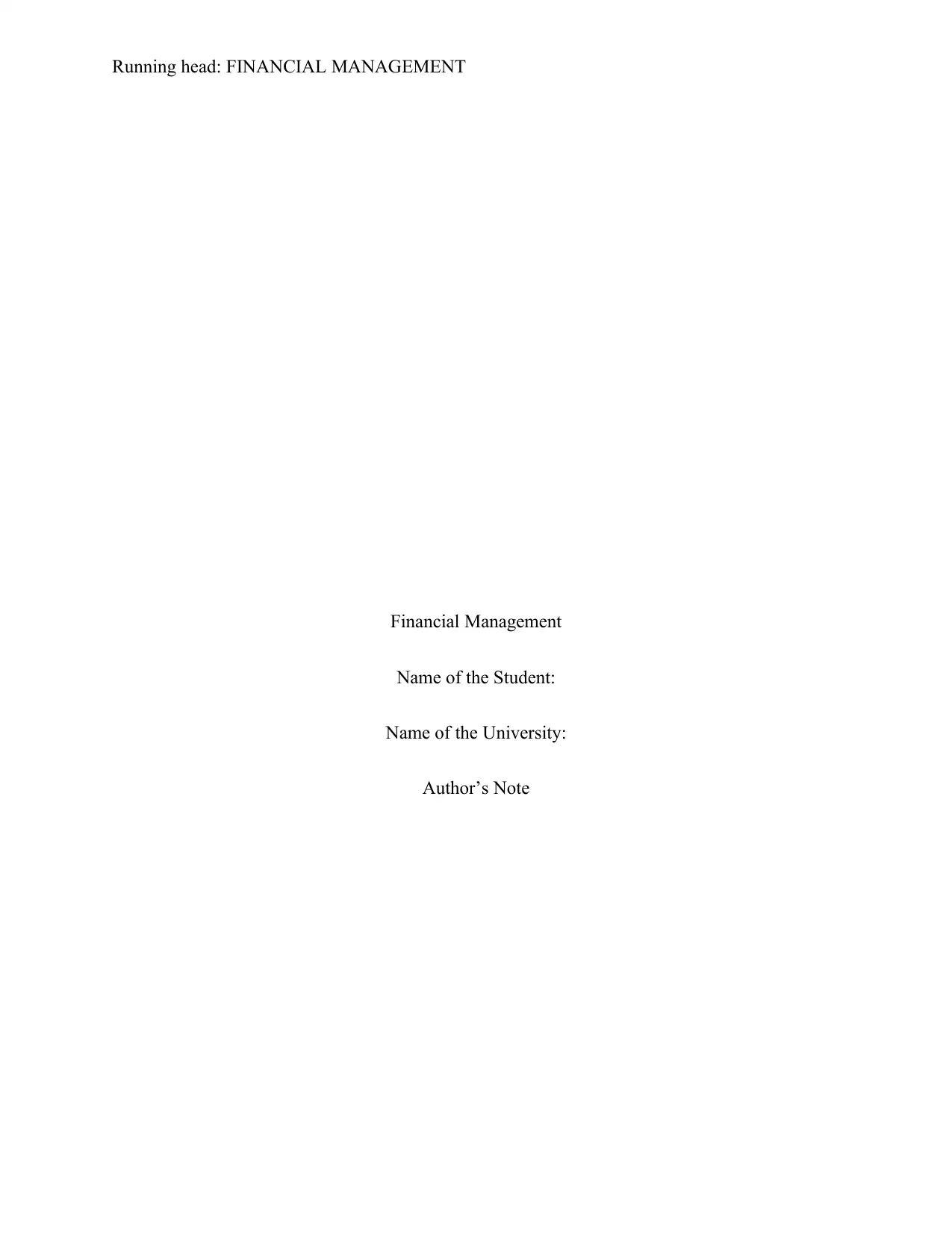
Running head: FINANCIAL MANAGEMENT
Financial Management
Name of the Student:
Name of the University:
Author’s Note
Financial Management
Name of the Student:
Name of the University:
Author’s Note
Paraphrase This Document
Need a fresh take? Get an instant paraphrase of this document with our AI Paraphraser
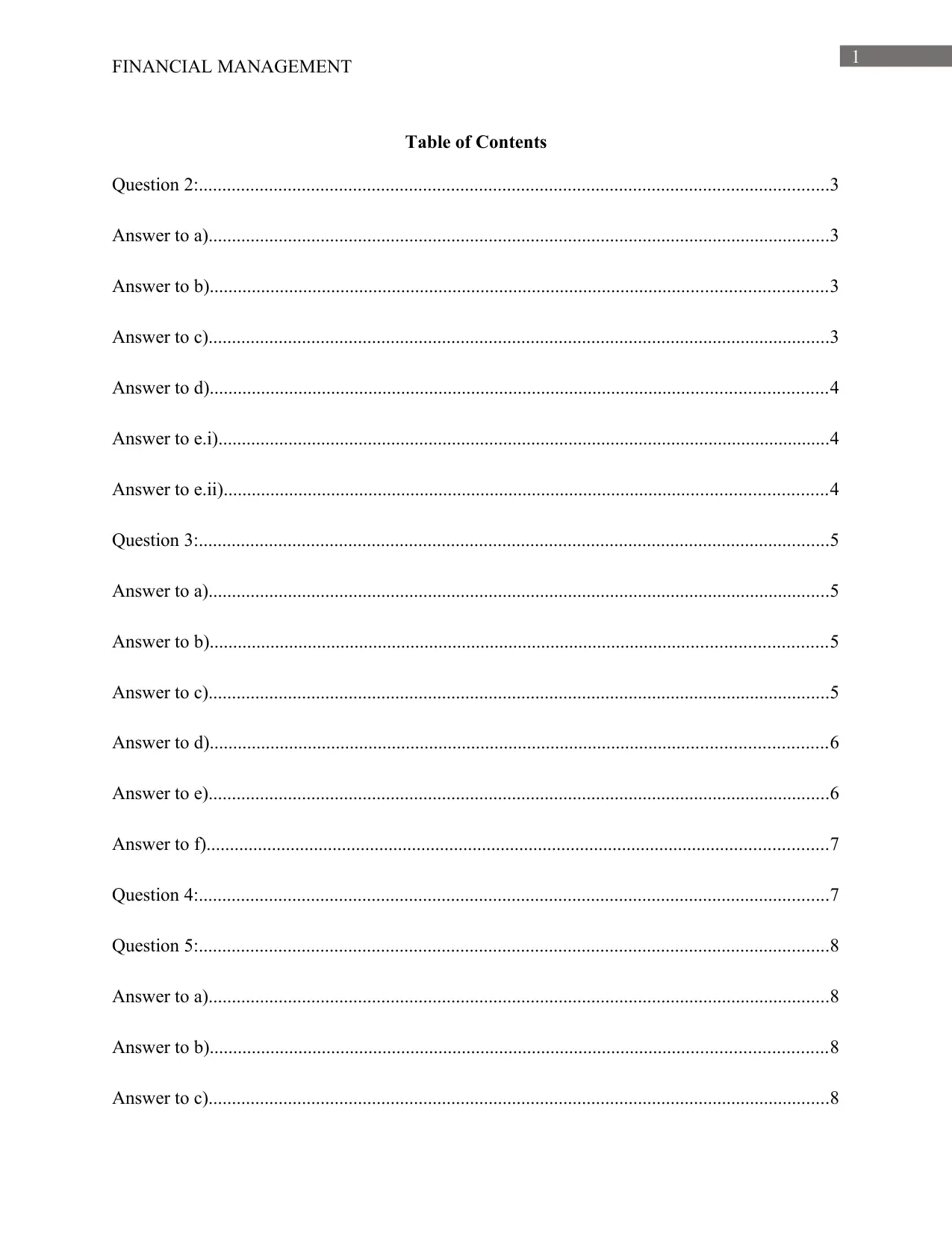
1
FINANCIAL MANAGEMENT
Table of Contents
Question 2:.......................................................................................................................................3
Answer to a).....................................................................................................................................3
Answer to b)....................................................................................................................................3
Answer to c).....................................................................................................................................3
Answer to d)....................................................................................................................................4
Answer to e.i)...................................................................................................................................4
Answer to e.ii).................................................................................................................................4
Question 3:.......................................................................................................................................5
Answer to a).....................................................................................................................................5
Answer to b)....................................................................................................................................5
Answer to c).....................................................................................................................................5
Answer to d)....................................................................................................................................6
Answer to e).....................................................................................................................................6
Answer to f).....................................................................................................................................7
Question 4:.......................................................................................................................................7
Question 5:.......................................................................................................................................8
Answer to a).....................................................................................................................................8
Answer to b)....................................................................................................................................8
Answer to c).....................................................................................................................................8
FINANCIAL MANAGEMENT
Table of Contents
Question 2:.......................................................................................................................................3
Answer to a).....................................................................................................................................3
Answer to b)....................................................................................................................................3
Answer to c).....................................................................................................................................3
Answer to d)....................................................................................................................................4
Answer to e.i)...................................................................................................................................4
Answer to e.ii).................................................................................................................................4
Question 3:.......................................................................................................................................5
Answer to a).....................................................................................................................................5
Answer to b)....................................................................................................................................5
Answer to c).....................................................................................................................................5
Answer to d)....................................................................................................................................6
Answer to e).....................................................................................................................................6
Answer to f).....................................................................................................................................7
Question 4:.......................................................................................................................................7
Question 5:.......................................................................................................................................8
Answer to a).....................................................................................................................................8
Answer to b)....................................................................................................................................8
Answer to c).....................................................................................................................................8
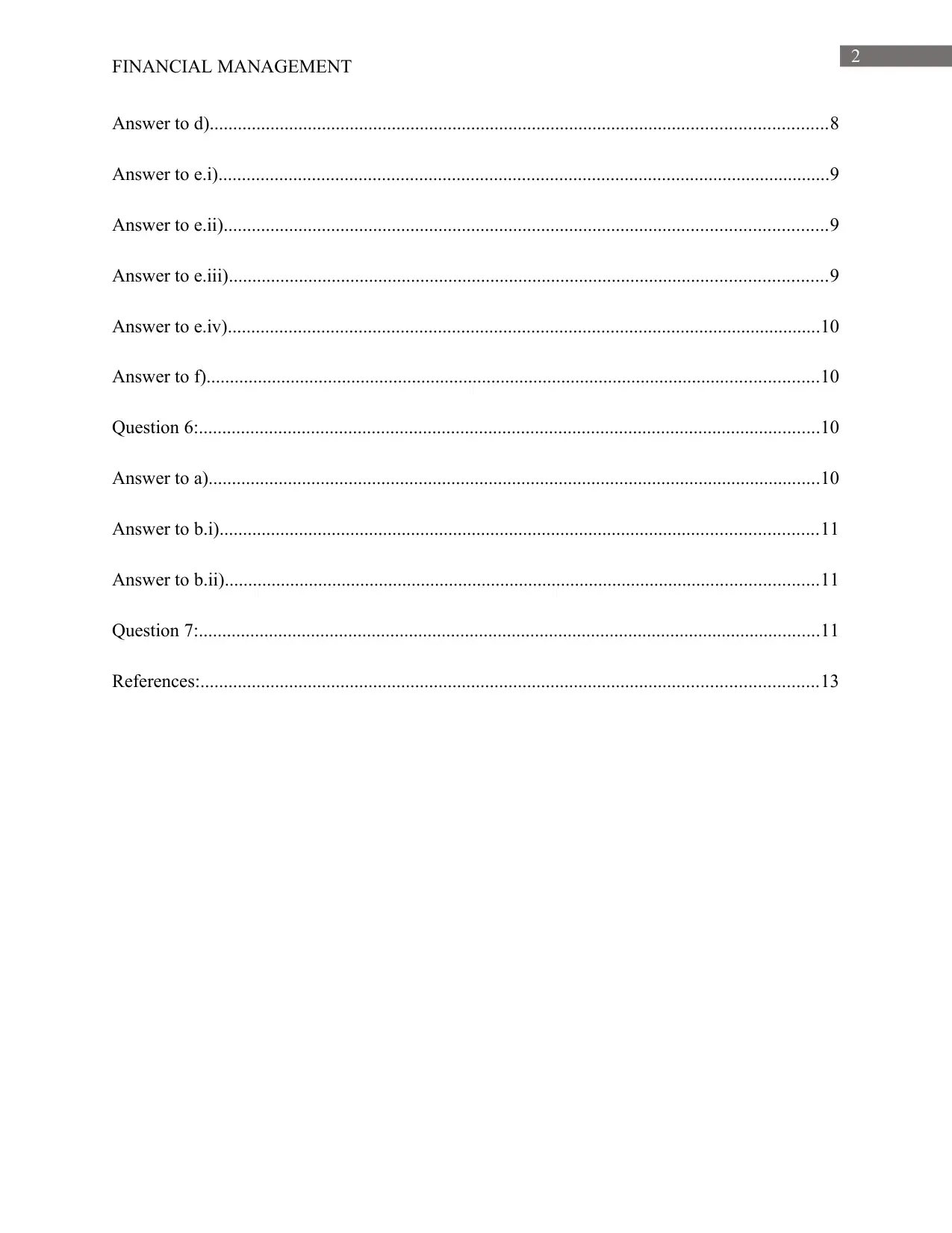
2
FINANCIAL MANAGEMENT
Answer to d)....................................................................................................................................8
Answer to e.i)...................................................................................................................................9
Answer to e.ii).................................................................................................................................9
Answer to e.iii)................................................................................................................................9
Answer to e.iv)...............................................................................................................................10
Answer to f)...................................................................................................................................10
Question 6:.....................................................................................................................................10
Answer to a)...................................................................................................................................10
Answer to b.i)................................................................................................................................11
Answer to b.ii)...............................................................................................................................11
Question 7:.....................................................................................................................................11
References:....................................................................................................................................13
FINANCIAL MANAGEMENT
Answer to d)....................................................................................................................................8
Answer to e.i)...................................................................................................................................9
Answer to e.ii).................................................................................................................................9
Answer to e.iii)................................................................................................................................9
Answer to e.iv)...............................................................................................................................10
Answer to f)...................................................................................................................................10
Question 6:.....................................................................................................................................10
Answer to a)...................................................................................................................................10
Answer to b.i)................................................................................................................................11
Answer to b.ii)...............................................................................................................................11
Question 7:.....................................................................................................................................11
References:....................................................................................................................................13
⊘ This is a preview!⊘
Do you want full access?
Subscribe today to unlock all pages.

Trusted by 1+ million students worldwide
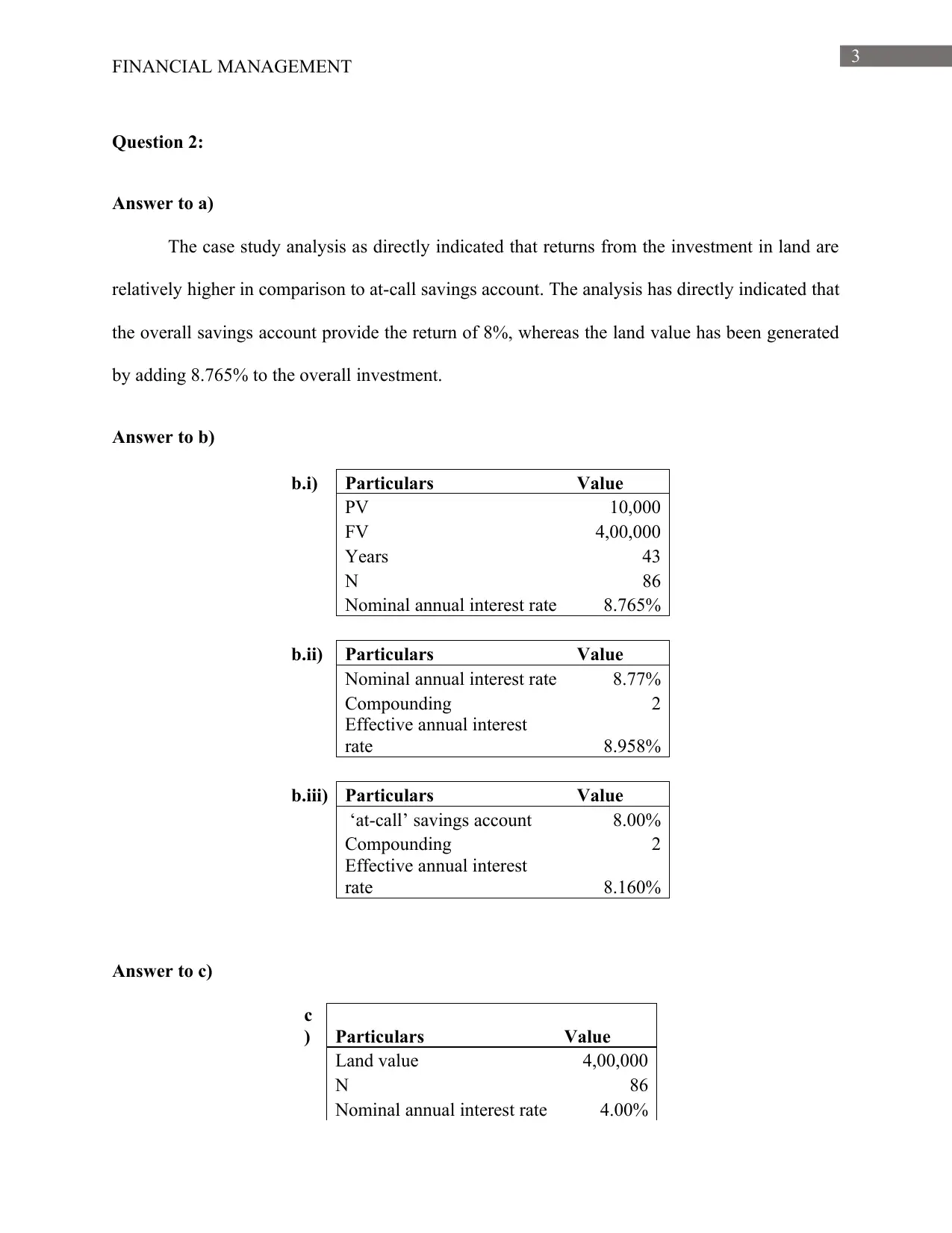
3
FINANCIAL MANAGEMENT
Question 2:
Answer to a)
The case study analysis as directly indicated that returns from the investment in land are
relatively higher in comparison to at-call savings account. The analysis has directly indicated that
the overall savings account provide the return of 8%, whereas the land value has been generated
by adding 8.765% to the overall investment.
Answer to b)
b.i) Particulars Value
PV 10,000
FV 4,00,000
Years 43
N 86
Nominal annual interest rate 8.765%
b.ii) Particulars Value
Nominal annual interest rate 8.77%
Compounding 2
Effective annual interest
rate 8.958%
b.iii) Particulars Value
‘at-call’ savings account 8.00%
Compounding 2
Effective annual interest
rate 8.160%
Answer to c)
c
) Particulars Value
Land value 4,00,000
N 86
Nominal annual interest rate 4.00%
FINANCIAL MANAGEMENT
Question 2:
Answer to a)
The case study analysis as directly indicated that returns from the investment in land are
relatively higher in comparison to at-call savings account. The analysis has directly indicated that
the overall savings account provide the return of 8%, whereas the land value has been generated
by adding 8.765% to the overall investment.
Answer to b)
b.i) Particulars Value
PV 10,000
FV 4,00,000
Years 43
N 86
Nominal annual interest rate 8.765%
b.ii) Particulars Value
Nominal annual interest rate 8.77%
Compounding 2
Effective annual interest
rate 8.958%
b.iii) Particulars Value
‘at-call’ savings account 8.00%
Compounding 2
Effective annual interest
rate 8.160%
Answer to c)
c
) Particulars Value
Land value 4,00,000
N 86
Nominal annual interest rate 4.00%
Paraphrase This Document
Need a fresh take? Get an instant paraphrase of this document with our AI Paraphraser
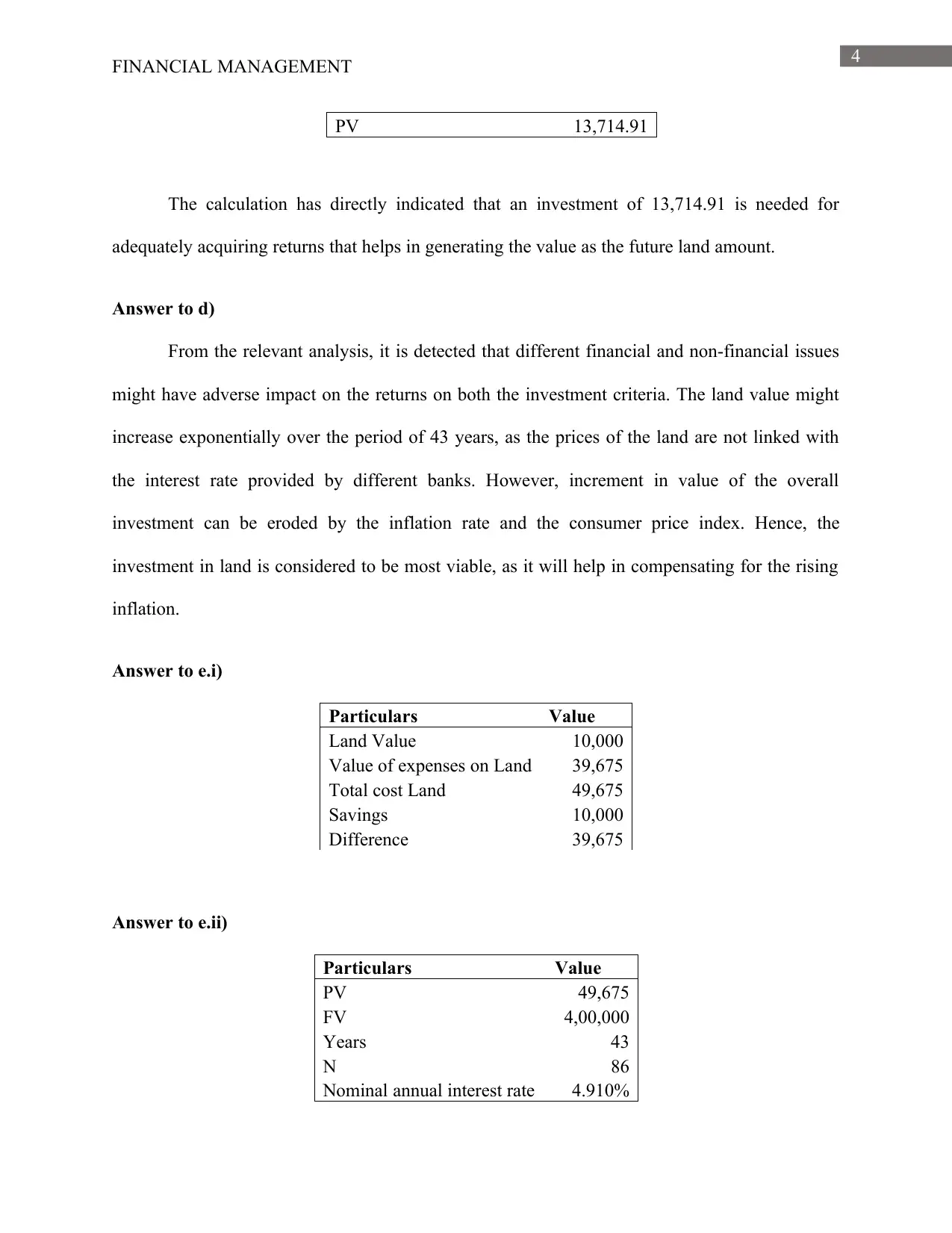
4
FINANCIAL MANAGEMENT
PV 13,714.91
The calculation has directly indicated that an investment of 13,714.91 is needed for
adequately acquiring returns that helps in generating the value as the future land amount.
Answer to d)
From the relevant analysis, it is detected that different financial and non-financial issues
might have adverse impact on the returns on both the investment criteria. The land value might
increase exponentially over the period of 43 years, as the prices of the land are not linked with
the interest rate provided by different banks. However, increment in value of the overall
investment can be eroded by the inflation rate and the consumer price index. Hence, the
investment in land is considered to be most viable, as it will help in compensating for the rising
inflation.
Answer to e.i)
Particulars Value
Land Value 10,000
Value of expenses on Land 39,675
Total cost Land 49,675
Savings 10,000
Difference 39,675
Answer to e.ii)
Particulars Value
PV 49,675
FV 4,00,000
Years 43
N 86
Nominal annual interest rate 4.910%
FINANCIAL MANAGEMENT
PV 13,714.91
The calculation has directly indicated that an investment of 13,714.91 is needed for
adequately acquiring returns that helps in generating the value as the future land amount.
Answer to d)
From the relevant analysis, it is detected that different financial and non-financial issues
might have adverse impact on the returns on both the investment criteria. The land value might
increase exponentially over the period of 43 years, as the prices of the land are not linked with
the interest rate provided by different banks. However, increment in value of the overall
investment can be eroded by the inflation rate and the consumer price index. Hence, the
investment in land is considered to be most viable, as it will help in compensating for the rising
inflation.
Answer to e.i)
Particulars Value
Land Value 10,000
Value of expenses on Land 39,675
Total cost Land 49,675
Savings 10,000
Difference 39,675
Answer to e.ii)
Particulars Value
PV 49,675
FV 4,00,000
Years 43
N 86
Nominal annual interest rate 4.910%
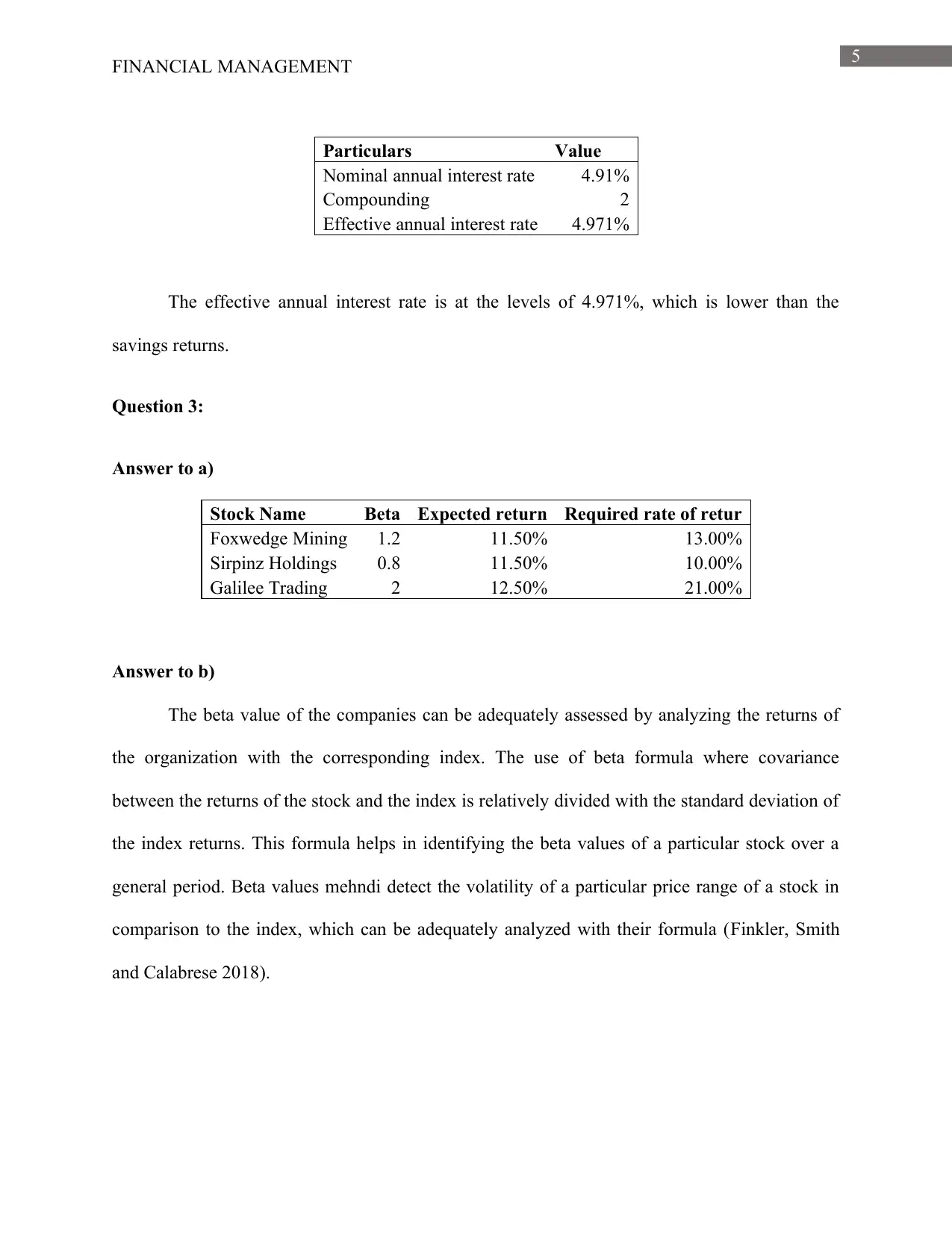
5
FINANCIAL MANAGEMENT
Particulars Value
Nominal annual interest rate 4.91%
Compounding 2
Effective annual interest rate 4.971%
The effective annual interest rate is at the levels of 4.971%, which is lower than the
savings returns.
Question 3:
Answer to a)
Stock Name Beta Expected return Required rate of retur
Foxwedge Mining 1.2 11.50% 13.00%
Sirpinz Holdings 0.8 11.50% 10.00%
Galilee Trading 2 12.50% 21.00%
Answer to b)
The beta value of the companies can be adequately assessed by analyzing the returns of
the organization with the corresponding index. The use of beta formula where covariance
between the returns of the stock and the index is relatively divided with the standard deviation of
the index returns. This formula helps in identifying the beta values of a particular stock over a
general period. Beta values mehndi detect the volatility of a particular price range of a stock in
comparison to the index, which can be adequately analyzed with their formula (Finkler, Smith
and Calabrese 2018).
FINANCIAL MANAGEMENT
Particulars Value
Nominal annual interest rate 4.91%
Compounding 2
Effective annual interest rate 4.971%
The effective annual interest rate is at the levels of 4.971%, which is lower than the
savings returns.
Question 3:
Answer to a)
Stock Name Beta Expected return Required rate of retur
Foxwedge Mining 1.2 11.50% 13.00%
Sirpinz Holdings 0.8 11.50% 10.00%
Galilee Trading 2 12.50% 21.00%
Answer to b)
The beta value of the companies can be adequately assessed by analyzing the returns of
the organization with the corresponding index. The use of beta formula where covariance
between the returns of the stock and the index is relatively divided with the standard deviation of
the index returns. This formula helps in identifying the beta values of a particular stock over a
general period. Beta values mehndi detect the volatility of a particular price range of a stock in
comparison to the index, which can be adequately analyzed with their formula (Finkler, Smith
and Calabrese 2018).
⊘ This is a preview!⊘
Do you want full access?
Subscribe today to unlock all pages.

Trusted by 1+ million students worldwide
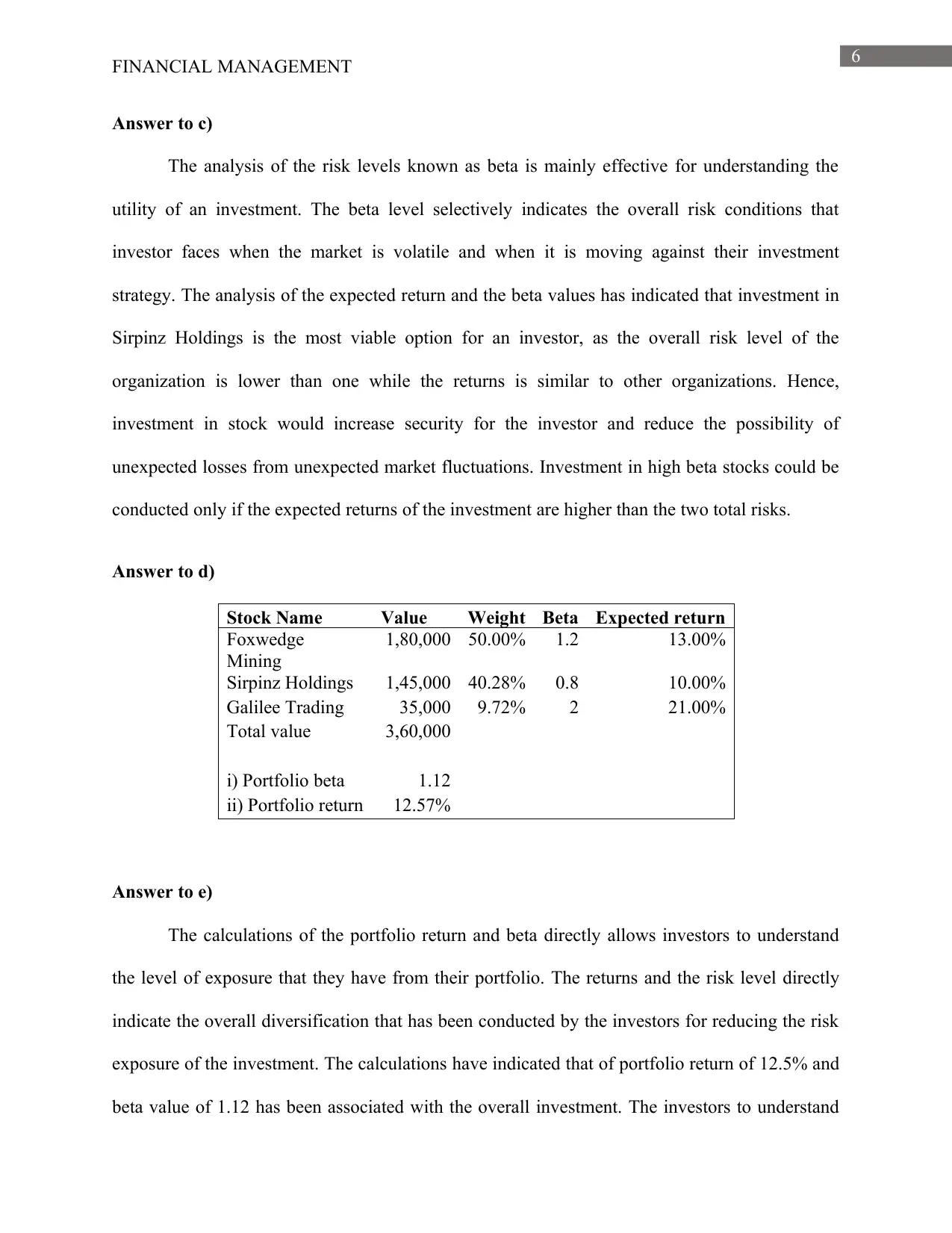
6
FINANCIAL MANAGEMENT
Answer to c)
The analysis of the risk levels known as beta is mainly effective for understanding the
utility of an investment. The beta level selectively indicates the overall risk conditions that
investor faces when the market is volatile and when it is moving against their investment
strategy. The analysis of the expected return and the beta values has indicated that investment in
Sirpinz Holdings is the most viable option for an investor, as the overall risk level of the
organization is lower than one while the returns is similar to other organizations. Hence,
investment in stock would increase security for the investor and reduce the possibility of
unexpected losses from unexpected market fluctuations. Investment in high beta stocks could be
conducted only if the expected returns of the investment are higher than the two total risks.
Answer to d)
Stock Name Value Weight Beta Expected return
Foxwedge
Mining
1,80,000 50.00% 1.2 13.00%
Sirpinz Holdings 1,45,000 40.28% 0.8 10.00%
Galilee Trading 35,000 9.72% 2 21.00%
Total value 3,60,000
i) Portfolio beta 1.12
ii) Portfolio return 12.57%
Answer to e)
The calculations of the portfolio return and beta directly allows investors to understand
the level of exposure that they have from their portfolio. The returns and the risk level directly
indicate the overall diversification that has been conducted by the investors for reducing the risk
exposure of the investment. The calculations have indicated that of portfolio return of 12.5% and
beta value of 1.12 has been associated with the overall investment. The investors to understand
FINANCIAL MANAGEMENT
Answer to c)
The analysis of the risk levels known as beta is mainly effective for understanding the
utility of an investment. The beta level selectively indicates the overall risk conditions that
investor faces when the market is volatile and when it is moving against their investment
strategy. The analysis of the expected return and the beta values has indicated that investment in
Sirpinz Holdings is the most viable option for an investor, as the overall risk level of the
organization is lower than one while the returns is similar to other organizations. Hence,
investment in stock would increase security for the investor and reduce the possibility of
unexpected losses from unexpected market fluctuations. Investment in high beta stocks could be
conducted only if the expected returns of the investment are higher than the two total risks.
Answer to d)
Stock Name Value Weight Beta Expected return
Foxwedge
Mining
1,80,000 50.00% 1.2 13.00%
Sirpinz Holdings 1,45,000 40.28% 0.8 10.00%
Galilee Trading 35,000 9.72% 2 21.00%
Total value 3,60,000
i) Portfolio beta 1.12
ii) Portfolio return 12.57%
Answer to e)
The calculations of the portfolio return and beta directly allows investors to understand
the level of exposure that they have from their portfolio. The returns and the risk level directly
indicate the overall diversification that has been conducted by the investors for reducing the risk
exposure of the investment. The calculations have indicated that of portfolio return of 12.5% and
beta value of 1.12 has been associated with the overall investment. The investors to understand
Paraphrase This Document
Need a fresh take? Get an instant paraphrase of this document with our AI Paraphraser
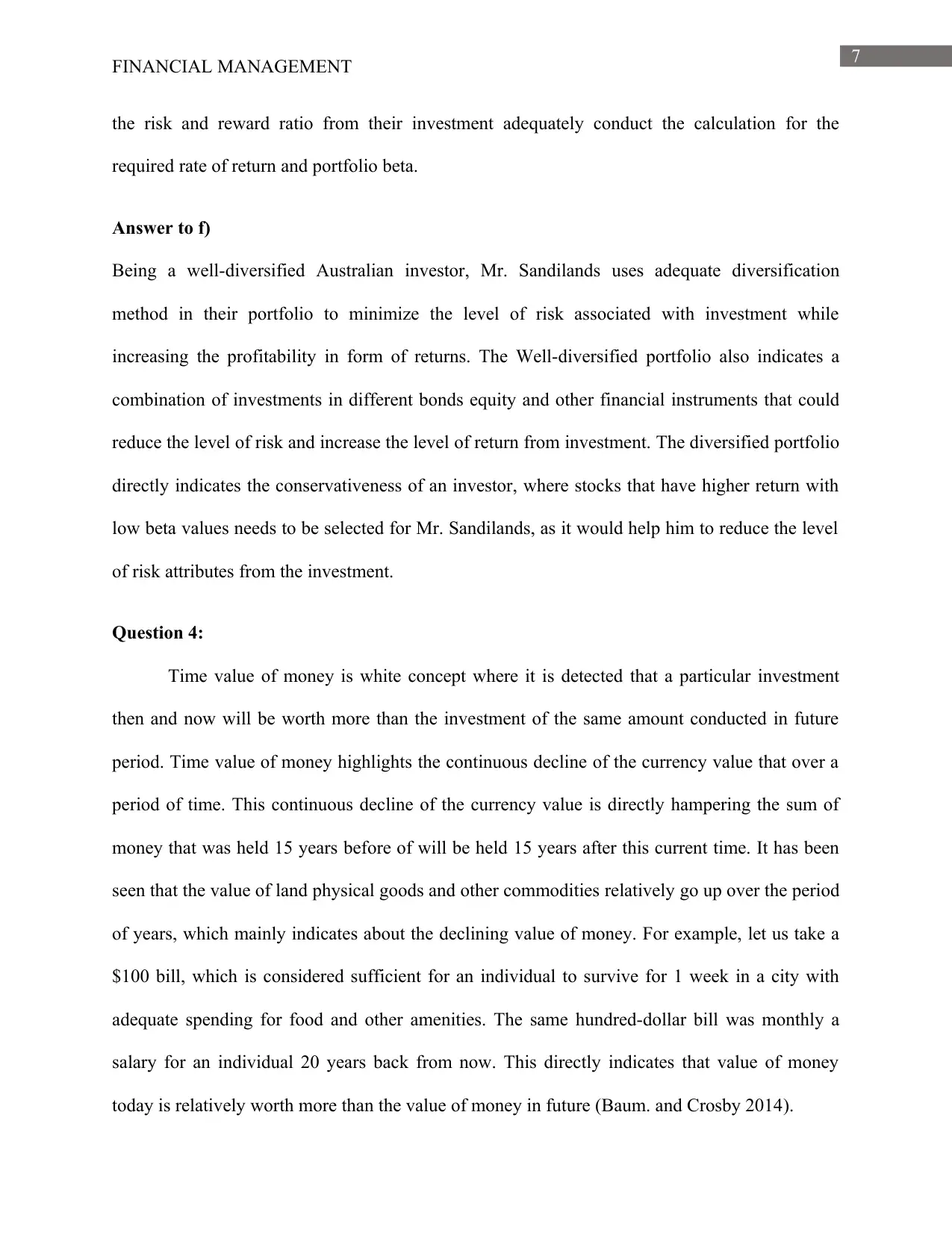
7
FINANCIAL MANAGEMENT
the risk and reward ratio from their investment adequately conduct the calculation for the
required rate of return and portfolio beta.
Answer to f)
Being a well-diversified Australian investor, Mr. Sandilands uses adequate diversification
method in their portfolio to minimize the level of risk associated with investment while
increasing the profitability in form of returns. The Well-diversified portfolio also indicates a
combination of investments in different bonds equity and other financial instruments that could
reduce the level of risk and increase the level of return from investment. The diversified portfolio
directly indicates the conservativeness of an investor, where stocks that have higher return with
low beta values needs to be selected for Mr. Sandilands, as it would help him to reduce the level
of risk attributes from the investment.
Question 4:
Time value of money is white concept where it is detected that a particular investment
then and now will be worth more than the investment of the same amount conducted in future
period. Time value of money highlights the continuous decline of the currency value that over a
period of time. This continuous decline of the currency value is directly hampering the sum of
money that was held 15 years before of will be held 15 years after this current time. It has been
seen that the value of land physical goods and other commodities relatively go up over the period
of years, which mainly indicates about the declining value of money. For example, let us take a
$100 bill, which is considered sufficient for an individual to survive for 1 week in a city with
adequate spending for food and other amenities. The same hundred-dollar bill was monthly a
salary for an individual 20 years back from now. This directly indicates that value of money
today is relatively worth more than the value of money in future (Baum. and Crosby 2014).
FINANCIAL MANAGEMENT
the risk and reward ratio from their investment adequately conduct the calculation for the
required rate of return and portfolio beta.
Answer to f)
Being a well-diversified Australian investor, Mr. Sandilands uses adequate diversification
method in their portfolio to minimize the level of risk associated with investment while
increasing the profitability in form of returns. The Well-diversified portfolio also indicates a
combination of investments in different bonds equity and other financial instruments that could
reduce the level of risk and increase the level of return from investment. The diversified portfolio
directly indicates the conservativeness of an investor, where stocks that have higher return with
low beta values needs to be selected for Mr. Sandilands, as it would help him to reduce the level
of risk attributes from the investment.
Question 4:
Time value of money is white concept where it is detected that a particular investment
then and now will be worth more than the investment of the same amount conducted in future
period. Time value of money highlights the continuous decline of the currency value that over a
period of time. This continuous decline of the currency value is directly hampering the sum of
money that was held 15 years before of will be held 15 years after this current time. It has been
seen that the value of land physical goods and other commodities relatively go up over the period
of years, which mainly indicates about the declining value of money. For example, let us take a
$100 bill, which is considered sufficient for an individual to survive for 1 week in a city with
adequate spending for food and other amenities. The same hundred-dollar bill was monthly a
salary for an individual 20 years back from now. This directly indicates that value of money
today is relatively worth more than the value of money in future (Baum. and Crosby 2014).
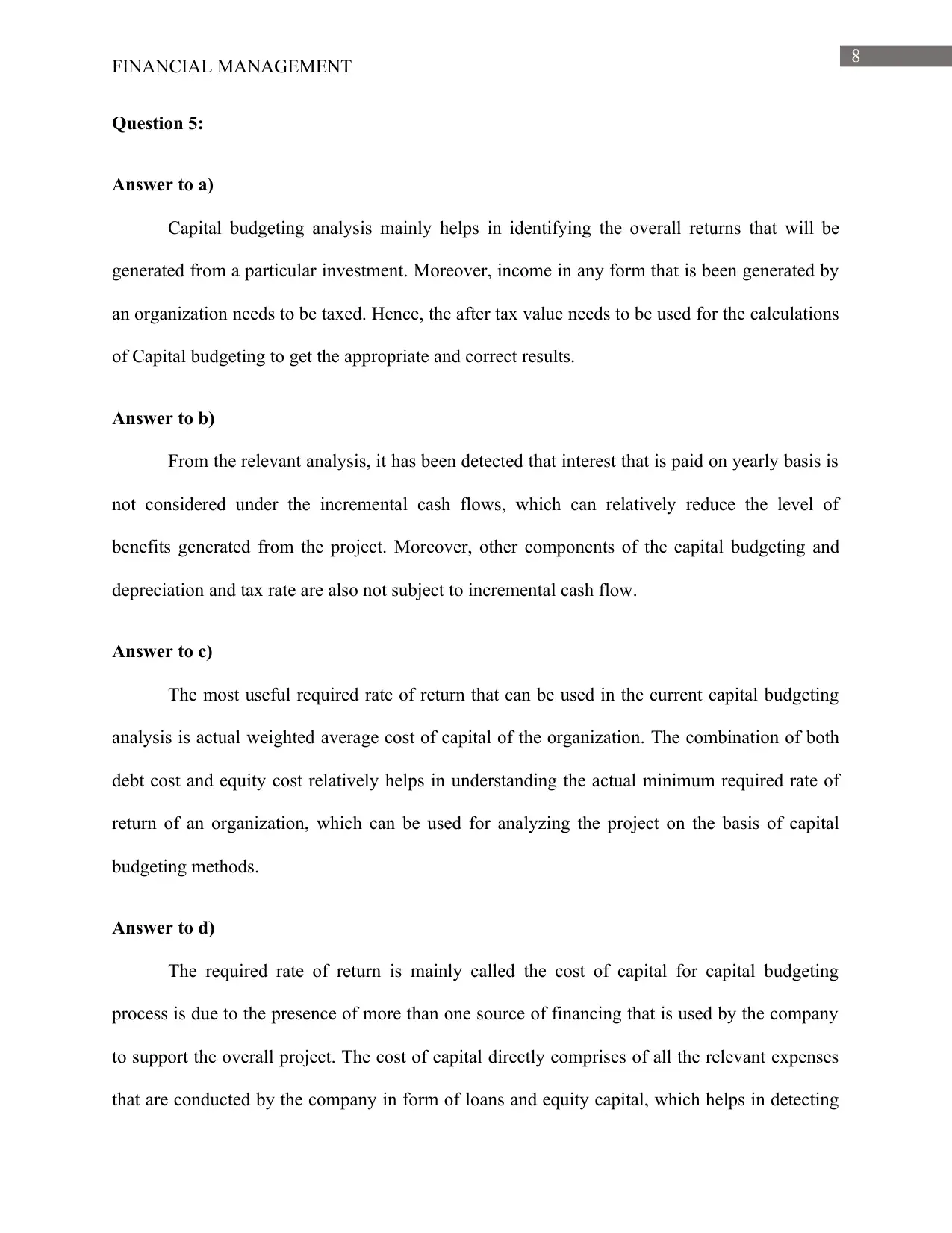
8
FINANCIAL MANAGEMENT
Question 5:
Answer to a)
Capital budgeting analysis mainly helps in identifying the overall returns that will be
generated from a particular investment. Moreover, income in any form that is been generated by
an organization needs to be taxed. Hence, the after tax value needs to be used for the calculations
of Capital budgeting to get the appropriate and correct results.
Answer to b)
From the relevant analysis, it has been detected that interest that is paid on yearly basis is
not considered under the incremental cash flows, which can relatively reduce the level of
benefits generated from the project. Moreover, other components of the capital budgeting and
depreciation and tax rate are also not subject to incremental cash flow.
Answer to c)
The most useful required rate of return that can be used in the current capital budgeting
analysis is actual weighted average cost of capital of the organization. The combination of both
debt cost and equity cost relatively helps in understanding the actual minimum required rate of
return of an organization, which can be used for analyzing the project on the basis of capital
budgeting methods.
Answer to d)
The required rate of return is mainly called the cost of capital for capital budgeting
process is due to the presence of more than one source of financing that is used by the company
to support the overall project. The cost of capital directly comprises of all the relevant expenses
that are conducted by the company in form of loans and equity capital, which helps in detecting
FINANCIAL MANAGEMENT
Question 5:
Answer to a)
Capital budgeting analysis mainly helps in identifying the overall returns that will be
generated from a particular investment. Moreover, income in any form that is been generated by
an organization needs to be taxed. Hence, the after tax value needs to be used for the calculations
of Capital budgeting to get the appropriate and correct results.
Answer to b)
From the relevant analysis, it has been detected that interest that is paid on yearly basis is
not considered under the incremental cash flows, which can relatively reduce the level of
benefits generated from the project. Moreover, other components of the capital budgeting and
depreciation and tax rate are also not subject to incremental cash flow.
Answer to c)
The most useful required rate of return that can be used in the current capital budgeting
analysis is actual weighted average cost of capital of the organization. The combination of both
debt cost and equity cost relatively helps in understanding the actual minimum required rate of
return of an organization, which can be used for analyzing the project on the basis of capital
budgeting methods.
Answer to d)
The required rate of return is mainly called the cost of capital for capital budgeting
process is due to the presence of more than one source of financing that is used by the company
to support the overall project. The cost of capital directly comprises of all the relevant expenses
that are conducted by the company in form of loans and equity capital, which helps in detecting
⊘ This is a preview!⊘
Do you want full access?
Subscribe today to unlock all pages.

Trusted by 1+ million students worldwide
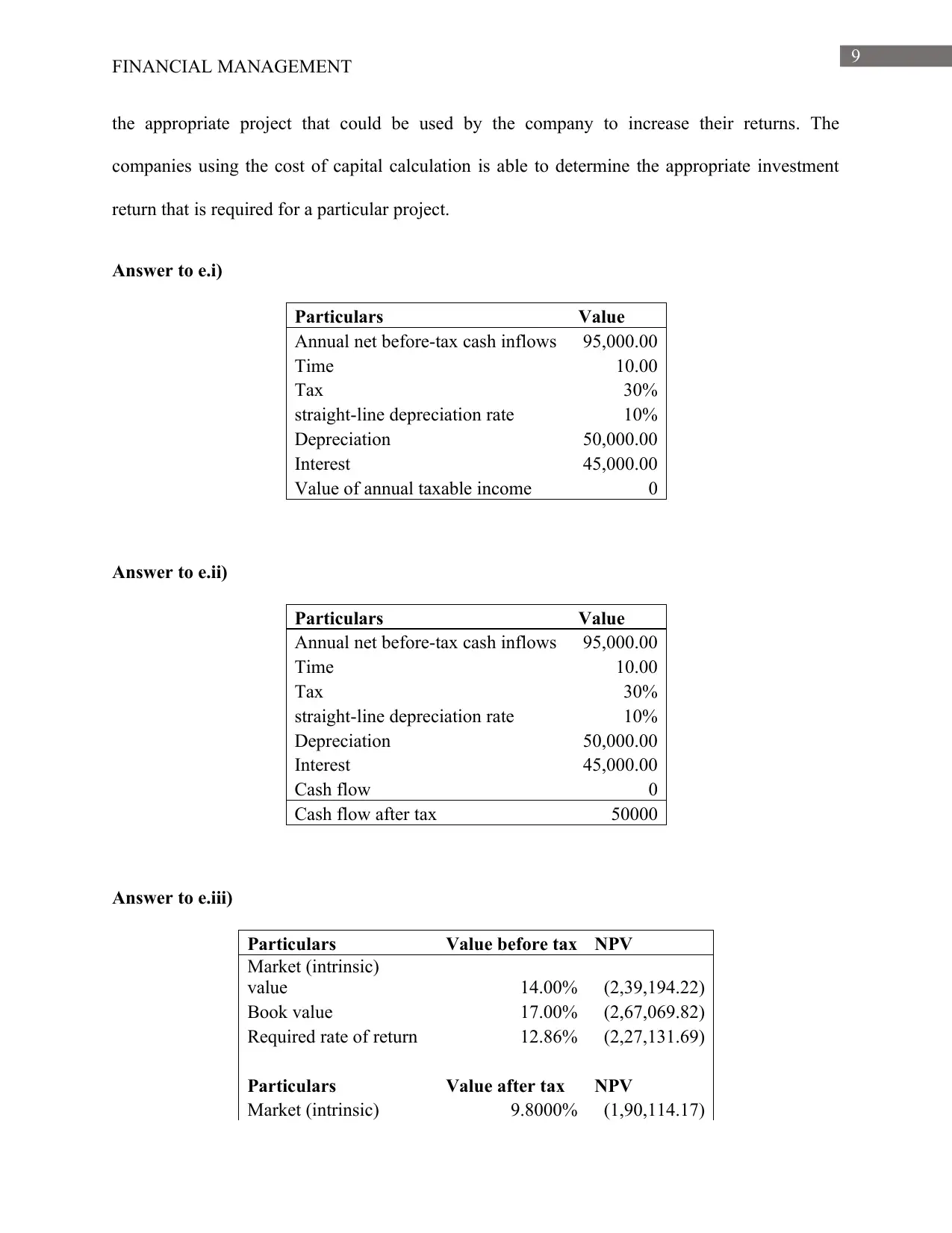
9
FINANCIAL MANAGEMENT
the appropriate project that could be used by the company to increase their returns. The
companies using the cost of capital calculation is able to determine the appropriate investment
return that is required for a particular project.
Answer to e.i)
Particulars Value
Annual net before-tax cash inflows 95,000.00
Time 10.00
Tax 30%
straight-line depreciation rate 10%
Depreciation 50,000.00
Interest 45,000.00
Value of annual taxable income 0
Answer to e.ii)
Particulars Value
Annual net before-tax cash inflows 95,000.00
Time 10.00
Tax 30%
straight-line depreciation rate 10%
Depreciation 50,000.00
Interest 45,000.00
Cash flow 0
Cash flow after tax 50000
Answer to e.iii)
Particulars Value before tax NPV
Market (intrinsic)
value 14.00% (2,39,194.22)
Book value 17.00% (2,67,069.82)
Required rate of return 12.86% (2,27,131.69)
Particulars Value after tax NPV
Market (intrinsic) 9.8000% (1,90,114.17)
FINANCIAL MANAGEMENT
the appropriate project that could be used by the company to increase their returns. The
companies using the cost of capital calculation is able to determine the appropriate investment
return that is required for a particular project.
Answer to e.i)
Particulars Value
Annual net before-tax cash inflows 95,000.00
Time 10.00
Tax 30%
straight-line depreciation rate 10%
Depreciation 50,000.00
Interest 45,000.00
Value of annual taxable income 0
Answer to e.ii)
Particulars Value
Annual net before-tax cash inflows 95,000.00
Time 10.00
Tax 30%
straight-line depreciation rate 10%
Depreciation 50,000.00
Interest 45,000.00
Cash flow 0
Cash flow after tax 50000
Answer to e.iii)
Particulars Value before tax NPV
Market (intrinsic)
value 14.00% (2,39,194.22)
Book value 17.00% (2,67,069.82)
Required rate of return 12.86% (2,27,131.69)
Particulars Value after tax NPV
Market (intrinsic) 9.8000% (1,90,114.17)
Paraphrase This Document
Need a fresh take? Get an instant paraphrase of this document with our AI Paraphraser
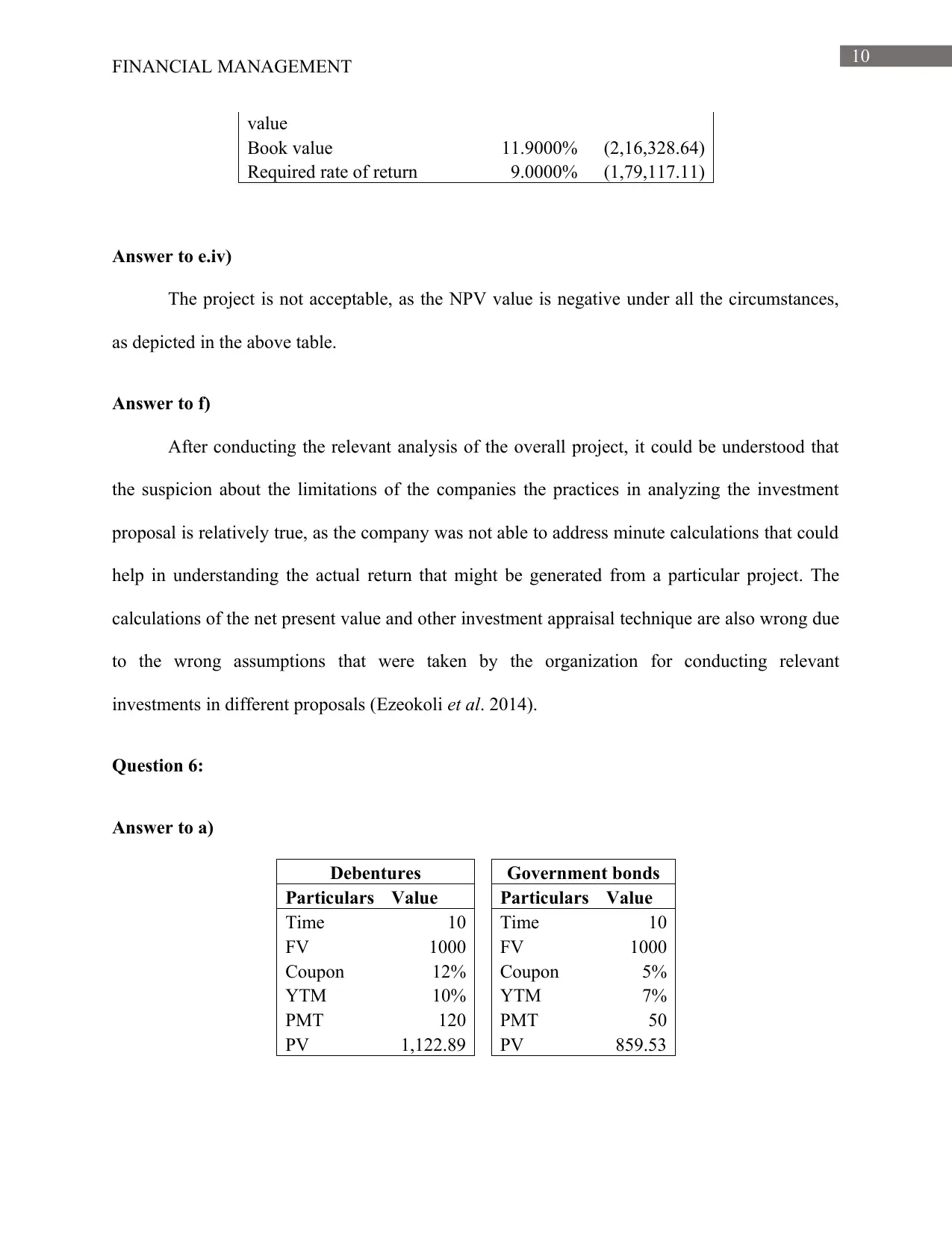
10
FINANCIAL MANAGEMENT
value
Book value 11.9000% (2,16,328.64)
Required rate of return 9.0000% (1,79,117.11)
Answer to e.iv)
The project is not acceptable, as the NPV value is negative under all the circumstances,
as depicted in the above table.
Answer to f)
After conducting the relevant analysis of the overall project, it could be understood that
the suspicion about the limitations of the companies the practices in analyzing the investment
proposal is relatively true, as the company was not able to address minute calculations that could
help in understanding the actual return that might be generated from a particular project. The
calculations of the net present value and other investment appraisal technique are also wrong due
to the wrong assumptions that were taken by the organization for conducting relevant
investments in different proposals (Ezeokoli et al. 2014).
Question 6:
Answer to a)
Debentures Government bonds
Particulars Value Particulars Value
Time 10 Time 10
FV 1000 FV 1000
Coupon 12% Coupon 5%
YTM 10% YTM 7%
PMT 120 PMT 50
PV 1,122.89 PV 859.53
FINANCIAL MANAGEMENT
value
Book value 11.9000% (2,16,328.64)
Required rate of return 9.0000% (1,79,117.11)
Answer to e.iv)
The project is not acceptable, as the NPV value is negative under all the circumstances,
as depicted in the above table.
Answer to f)
After conducting the relevant analysis of the overall project, it could be understood that
the suspicion about the limitations of the companies the practices in analyzing the investment
proposal is relatively true, as the company was not able to address minute calculations that could
help in understanding the actual return that might be generated from a particular project. The
calculations of the net present value and other investment appraisal technique are also wrong due
to the wrong assumptions that were taken by the organization for conducting relevant
investments in different proposals (Ezeokoli et al. 2014).
Question 6:
Answer to a)
Debentures Government bonds
Particulars Value Particulars Value
Time 10 Time 10
FV 1000 FV 1000
Coupon 12% Coupon 5%
YTM 10% YTM 7%
PMT 120 PMT 50
PV 1,122.89 PV 859.53
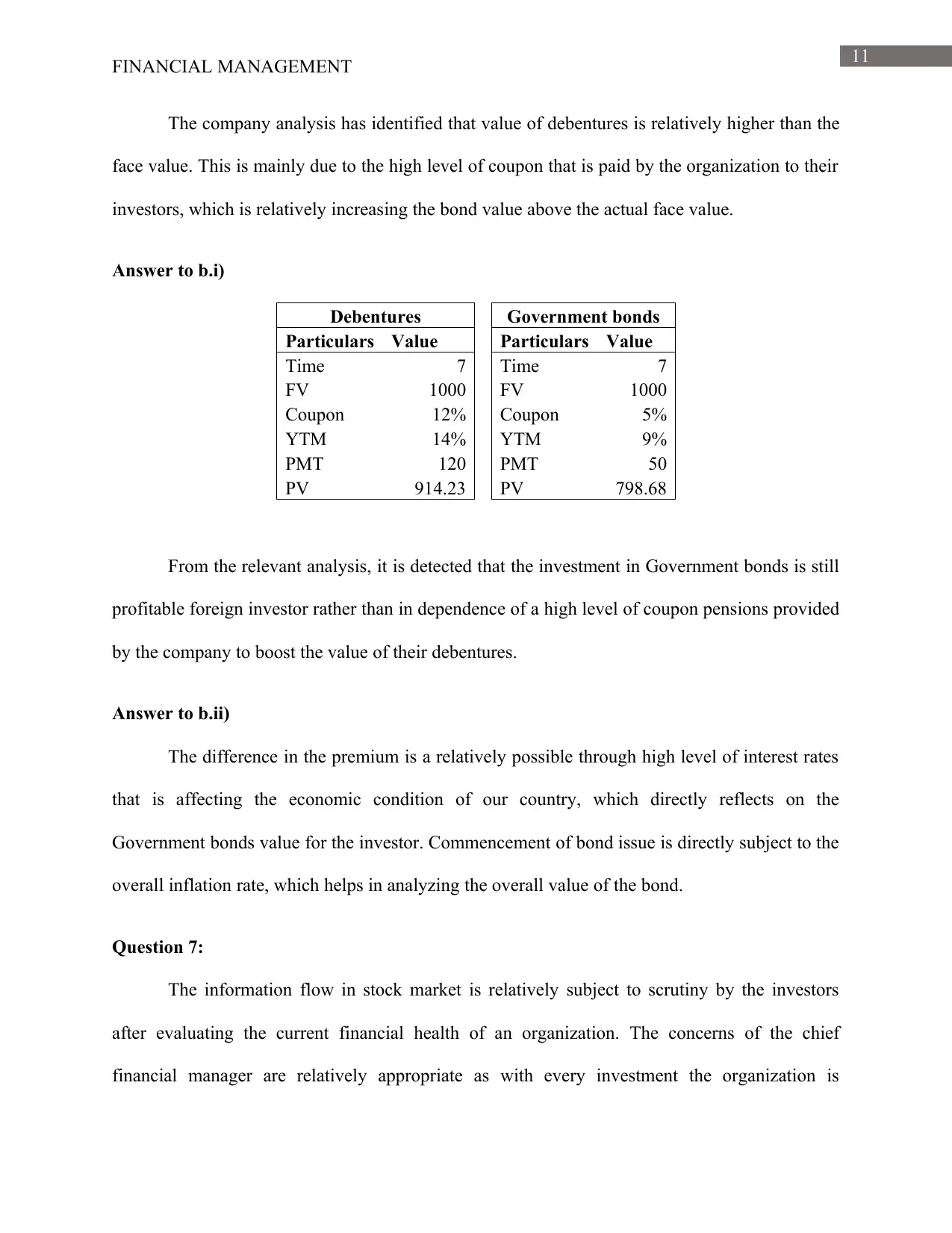
11
FINANCIAL MANAGEMENT
The company analysis has identified that value of debentures is relatively higher than the
face value. This is mainly due to the high level of coupon that is paid by the organization to their
investors, which is relatively increasing the bond value above the actual face value.
Answer to b.i)
Debentures Government bonds
Particulars Value Particulars Value
Time 7 Time 7
FV 1000 FV 1000
Coupon 12% Coupon 5%
YTM 14% YTM 9%
PMT 120 PMT 50
PV 914.23 PV 798.68
From the relevant analysis, it is detected that the investment in Government bonds is still
profitable foreign investor rather than in dependence of a high level of coupon pensions provided
by the company to boost the value of their debentures.
Answer to b.ii)
The difference in the premium is a relatively possible through high level of interest rates
that is affecting the economic condition of our country, which directly reflects on the
Government bonds value for the investor. Commencement of bond issue is directly subject to the
overall inflation rate, which helps in analyzing the overall value of the bond.
Question 7:
The information flow in stock market is relatively subject to scrutiny by the investors
after evaluating the current financial health of an organization. The concerns of the chief
financial manager are relatively appropriate as with every investment the organization is
FINANCIAL MANAGEMENT
The company analysis has identified that value of debentures is relatively higher than the
face value. This is mainly due to the high level of coupon that is paid by the organization to their
investors, which is relatively increasing the bond value above the actual face value.
Answer to b.i)
Debentures Government bonds
Particulars Value Particulars Value
Time 7 Time 7
FV 1000 FV 1000
Coupon 12% Coupon 5%
YTM 14% YTM 9%
PMT 120 PMT 50
PV 914.23 PV 798.68
From the relevant analysis, it is detected that the investment in Government bonds is still
profitable foreign investor rather than in dependence of a high level of coupon pensions provided
by the company to boost the value of their debentures.
Answer to b.ii)
The difference in the premium is a relatively possible through high level of interest rates
that is affecting the economic condition of our country, which directly reflects on the
Government bonds value for the investor. Commencement of bond issue is directly subject to the
overall inflation rate, which helps in analyzing the overall value of the bond.
Question 7:
The information flow in stock market is relatively subject to scrutiny by the investors
after evaluating the current financial health of an organization. The concerns of the chief
financial manager are relatively appropriate as with every investment the organization is
⊘ This is a preview!⊘
Do you want full access?
Subscribe today to unlock all pages.

Trusted by 1+ million students worldwide
1 out of 14
Related Documents
Your All-in-One AI-Powered Toolkit for Academic Success.
+13062052269
info@desklib.com
Available 24*7 on WhatsApp / Email
![[object Object]](/_next/static/media/star-bottom.7253800d.svg)
Unlock your academic potential
Copyright © 2020–2025 A2Z Services. All Rights Reserved. Developed and managed by ZUCOL.




